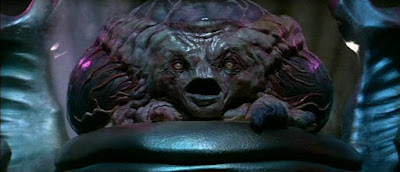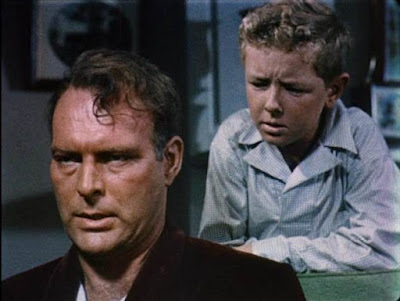Invaders from
Mars
(1953) Directed by: William Cameron Menzies; Written by Richard
Blake; Starring: Helena Carter, Arthur Franz, Jimmy Hunt, Leif Erickson and Hillary
Brooke
Available on DVD
Rating: ****
Invaders
from Mars (1986) Directed
by: Tobe Hooper; Written by Dan O’Bannon and Don Jakoby; Based on the original
1953 screenplay by Richard Blake; Starring: Karen Black, Hunter Carson, Timothy
Bottoms, Laraine Newman, James Karen, Louise Fletcher and Bud Cort
Available on Blu-ray
and DVD
Rating: **
“If you know my dad, there isn’t anybody like him, not anybody. But today he acted like somebody I never saw before.” – David MacLean (Jimmy Hunt)
“I thought it
was a picture well worth remaking because of…what I saw…the potential of what
could be brought to a contemporary audience.” – Tobe Hooper
Science Fiction
is an ideal forum to address the sort of subjects that would be unsavory in
some other, more “conventional” genres. Even in the darkest of times, clever
writers and filmmakers have managed to inject subversive elements in their work,
while appearing to produce “escapist” fare for the masses. We can address the
pink pachyderm in the room head on, confront our demons and shake hands with
our deepest fears. One such example is 1953’s Invaders from Mars, which blended elements from a child’s darkest
nightmares into a tale of Cold War paranoia. Three decades later, Tobe Hooper
saw fit to grace the world with his updated interpretation of one of the
defining sci-fi films of the 1950s. How did his version fare? Let’s take a
look…
Social Relevance
The original Invaders from Mars could be seen as a
commentary on ‘50s “gee whiz” optimism (yes, the main character even exclaims
“gee whiz.”) replaced by Cold War cynicism. The film falls in a sweet spot,
following The Thing from Another World
by a couple of years, and pre-dating Jack Finney’s novel Invasion of the Body Snatchers by the same time span. Director/production
designer William Cameron Menzies and crew obliged the prevailing xenophobia and
paranoia of the time, with alien invaders who would stop at nothing to
undermine the pillars of American society. One boy wakes up to discover his
family, friends and neighbors aren’t who they appear to be. He spends the rest
of the film trying to convince anyone who will listen that the residents of his
town are being manipulated by Martians to carry out their diabolical (albeit
vague) scheme for world domination. The whole message is diluted in Hooper’s
version, as the story services the effects, not the other way around. There’s so
much that could have been said, in a version re-tooled for the Reagan years. Instead,
Hopper just seems to be mimicking key scenes from the original film, creating a
pale imitation.
Verdict:
Original
Cinematography/Art
Design
Menzies’ film is
a textbook example of doing more with less. What the filmmakers might have
lacked in funds, they compensate with ingenuity. The distorted camera angles
and minimalist sets recall German expressionism, especially in the scene with
David (Jimmy Hunt) in the police station. The alien spacecraft interiors also
have a simple, understated design. Realism takes a back seat to tone, as we’re immersed
in a boy’s nightmare. By contrast, Leslie Dilley’s spacecraft sets look like a pale
imitation of H.R. Giger’s biomechanical designs for Alien.
Verdict:
Original
Effects
In the 1953
version, the creature effects were quaint at best (some might say cheesy). The Martian
invaders were human-like mutants, clad from head to toe in green footie
pajamas, complete with zipper up the back. Their leader appears as a head with
tentacles, encased in a glass globe, a representation of “mankind developed to
its ultimate intelligence.”
One gets the
feeling Hooper and his team tried to one-up the original with spectacle at
every step, from the obnoxious title sequence to the overdone spaceship
interior. In addition to Dilley, Hooper’s team included other talented
individuals, including John Dykstra and Stan Winston. With all due respect to
Winston and his brilliant achievements in creature effects, the Martians seem
borderline cute. With their giant mouths and awkward, rubbery gait, the Martian
guards recall something from Joe Dante’s Explorers.
I have to give Winston credit where it’s due, however, for his interesting re-interpretation
of the Martian leader, which emerges from a shaft like a giant birth canal.
* If you must
watch the remake, look out for a neat little Easter egg in the scene where
David and Linda escape into the school boiler room. Watch for a pile of Christmas
ornaments, including a globe housing the Martian leader from the original film.
Verdict: Tie
Performances
Jimmy Hunt does
an admirable job as David MacLean (he has a cameo as a cop in the remake), who keeps
a cool head in the face of adversity. His father (Leif Erickson) undergoes a
radical mood swing as he succumbs to Martian mind control. His rapid mood shift
is positively frightening. Helena Carter is also very good as Dr. Pat Blake, David’s
only ally in the fight against extra-terrestrial conquest.
Hooper assembled
a good cast of veteran character actors for the remake, but most of their
talent is wasted. In contrast to Erickson’s scary transformation, Timothy
Bottoms as David’s father doesn’t seem particularly threatening, just eccentric.
As a school nurse who’s prone to histrionics, Karen Black’s character is a step
down from Carter’s Dr. Blake (“You’re not just a crazy child, are you?”). Louise
Fletcher seems to be going through the motions in the usual thankless
villainess role we’ve grown to associate with her. As David, Hunter Carson
(Black’s real-life son) doesn’t fare any better than the rest of the ensemble.
His acting ranges from blank expressions to flailing his arms about and
shouting hysterically.
Verdict: Original
Overall Effectiveness
Both films take
a different approach with regard to introducing the invaders. The original
prefers a slow build (we don’t see the alien invaders or their lair until
two-thirds of the way in), but that time isn’t wasted. The filmmakers wisely
chose to leave it to the audience to speculate what was hidden underneath the
sand dune concealing the Martian ship. A haunting chorus accompanies the scenes
in which people are sucked into the ground. The tension is palpable as David wonders
who to trust, and an atmosphere of overwhelming paranoia mounts. In the remake,
things are taken at face value. Possibly a result of pandering to pressure from
Cannon Films, or a sign of the diminishing attention span of filmgoers, Hooper doesn’t
waste much time before we catch a glimpse of the alien spacecraft interior and
its weird inhabitants.
Verdict:
Original
In what has
become an all too common trend in remakes, what worked in the original film is
somehow lost in translation. The 1986 version follows the same
recipe and uses the same ingredients, but the recipe ends up tasting wrong. The
“bigger means better” approach recalls a line from Jeff Goldblum’s Ian Malcolm
in Jurassic Park, who lamented “…they
didn’t stop to think if they should.” Hooper somehow manages to screw up
everything that worked in Menzies’ original. Thanks to dodgy acting and an
ill-advised freeze frame, even the ending lacks the bite of the 1953 film.
While the 1986 film is a missed opportunity, the alien invasion trope is always
in style. Another 30 years have elapsed since the previous attempt, and the
story is ripe for another remake, re-tooled for the current, uncertain climate.













I dig it when you contrast and compare originals and remakes!
ReplyDeleteGlad that the original fared better in your review, Barry! It is definitely superior!
Thank you, John! I really need to do this type of segment more often.
Delete